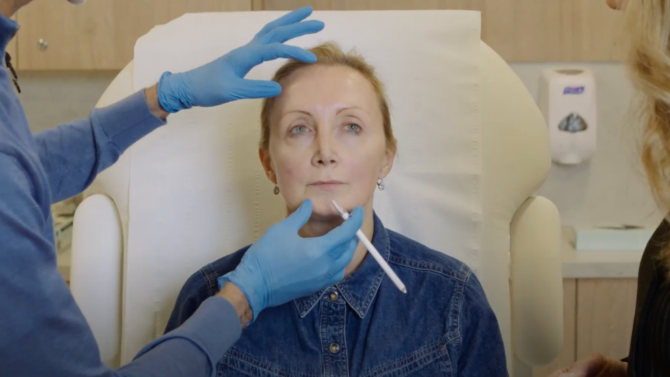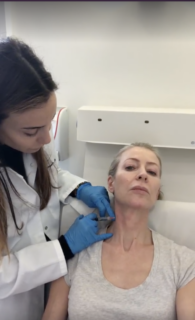If you are worried about thinning hair or a receding hairline, you are far from alone. Losing your hair is a very emotional (and common) experience and even aesthetic doctors – who we trust to tweak our faces back to their best – are not immune to the potential for spareness and bald spots too. In fact, to help anyone feeling nervous about considering a surgical solution like a hair transplant, the leading aesthetic doctor Dr David Jack has shared his experience of the surgery exclusively with The Tweakments Guide.
From why Dr Jack wanted to explore a hair transplant, to who he went to see and the results he achieved, read on to discover why regaining a thicker head of hair doesn’t have to be as scary as it might appear, with our interview-based insight into what aesthetic doctors actually have done themselves.
Why were you interested in a hair transplant?

“I first noticed my hair falling out during Covid,” explains Dr Jack. “Working with the public, I was exposed to the virus quite a few times and noticed a significant change in my hair thickness and quality with each exposure. Age could also have been a factor. In any case, my receding hairline was starting to bother me. Although I’d had PRP and other bio-stimulation treatments such as exosomes and Calecim over the past few years – the inevitable need for something a bit more nuclear was now upon me.”
Who did you go to see about your hair transplant?
“I decided to call on my friend Dr Chris D’Souza, who has become one of the UK’s most prominent hair transplant surgeons. Chris is renowned for creating very natural-looking hairlines. Having worked with him for many years, I knew I was in good hands.”
What type of hair transplant did you have?

Dr Jack had a FUE hair transplant, which stands for Follicular Unit Extraction. This technique involves extracting individual hair follicles from the back of the head and then implanting them in the balding area. It differs from the other common hair transplant method known as FUT or Follicular Unit Transplantation, as the latter involves removing a thin strip of hair-covered skin from the back of the head.
“FUE was the preferred technique in this case as David is young and his donor site was excellent,” explains Dr D’Souza. “The main advantage of FUE over FUT is there is no linear scar which allows for more flexibility regarding hair styling. The main downside is that patients are required to shave the back and sides of their head, but for David this was not an issue.”
What is the consultation process like for a hair transplant?
“A few weeks before my FUE hair transplant, Dr D’Souza and I sat down together to map out my future hairline,” explains Dr Jack. “I probably would have opted for a hairline starting just above my eyebrows, but during the meeting he reined me in a bit! He calmly explained his approach for planning the hairline based on my personal features, and also the technique he was going to use for placing the follicles, based on the number of hairs per follicle. The technique he uses ensures that the transplant very closely resembles the way the hairs grow naturally, so it doesn’t look overly linear or too like a Ken-doll.”
What is a hair transplant like to experience? Is it painful?
The main thing to note is that a hair transplant is a long procedure, but it doesn’t require you to be totally knocked out and isn’t considered to be too painful.
“All hair transplant surgeries at The D’Souza Clinic are performed in one day under local anaesthetic,” explains Dr D’Souza. “We give some mild sedation and some background pain relief. The majority of patients find the day passes quite quickly and spend their time watching TV or catching up on correspondence. We perform one case per day and in David’s case we started at 08:30 and were finished by 17:00.”
Here’s Dr Jack’s first-hand experience:
“On the day of the procedure, the clinic team were very relaxed and professional, which put me at ease,” reveals Dr Jack. “I opted to have my head shaved completely, but Chris explained this wasn’t necessary – many people prefer to keep their hair longer. To start, Chris planned the hairline and then injected local anaesthetic which was not particularly painful, making the scalp completely numb. Chris then began the meticulous process of planning harvesting follicles from the donor area and creating the micro-incisions in the recipient site. To my surprise, this part was completely painless. The transplantation itself was an exercise in precision: and after a good number of Netflix hours, it was over with almost no pain whatsoever.”
Is there a lot of downtime after a hair transplant?
“After the procedure, I travelled back to the countryside to recuperate,” says Dr Jack. “Dr Chris advised me to wear a tape on my forehead to reduce potential eyelid swelling, as well as a reducing dose of steroids to minimise puffiness and inflammation. I removed the tape after 72 hours, and while my scalp felt quite numb for a good week or so, there was very little swelling and I was able to return to work a few days later. Sleeping upright for the first few days post-procedure was perhaps the biggest challenge, especially for someone who, much against my usual advice to my patients, often sleeps on their side or front. The only other discomfort of the whole process came from a slight prickly pain at the donor site as it was healing around day five to seven – briefly reminding me that it had been subject to over 2,500 injuries!”
“The first five days post-op are the most important,” confirms Dr D’Souza. “The grafts are very delicate at this stage and we advise patients to spend this time at home. By day six post-op the grafts are relatively secure and a loose-fitting hat or cap can be worn. By two weeks post-op there is very little evidence of the surgery.”
What results did you get? Are you happy with your hair now?
“I routinely see my patients at six, 12 and 18 months post-op for checkups, and at six months we usually expect 50-60% of the final result, as initially the hair can be a little flimsy and frizzy, strengthening over time,” explains Dr D’Souza.
That’s exactly what Dr Jack is happily experiencing right now…
“At month six, I’m beginning to see the fruits of Dr d’Souza’s labour – new hairs are sprouting (including some greys transplanted from the back of my scalp!),” he reveals.
“The journey isn’t over, but with each passing day, I’m excited to witness the unfolding transformation. The coming months hold the promise of more growth and hopefully the hairline that left me a few years before! All in, this is a procedure I would highly recommend. I caveat this with the guidance that you must go to someone who is an expert in the field, like Dr D’Souza. This is both a technical and highly artistic process so choosing your surgeon carefully is exceptionally important.

The final surgical word:
“David is a 39-year-old male who presented with a history of three to four years of hair loss in the temples,” summarises Dr D’Souza. “He previously tried topical Minoxidil and PRP injections to maintain his existing hair, but wanted to explore hair transplant surgery to augment his hairline and increase the density in the frontal half. He was diagnosed with androgenetic alopecia and advised on the importance of Finasteride and Minoxidil in treating male pattern hair loss and ensuring a good long-term aesthetic result.
We proceeded with an FUE hair transplant to the frontal half and placed a total of 2,325 grafts. The breakdown of the grafts were as follows – 1’s – 352, 2’s – 1021, 3’s – 952 – the total number of hairs transplanted was 5,250 which makes an average hair count of 2.26. The 1’s were used to create a new hairline and the 2’s and 3’s to build up the density behind. We worked amongst existing hair to ensure as full a look as possible.”
Mr Christopher D’Souza, prices from £5,000, thedsouzaclinic.com
Related Stories

Concerns
The Tweakment Ladder: How To Take Your First Steps In Tweaks
Given the huge number of tweakments available, it’s increasingly hard to work out where you should...

Tweakments
Less Is More – How To ‘Press Pause’ On Ageing With Natural-Looking Filler
Can we really ‘press pause on ageing’ using dermal filler? Alice visited globally-renowned...

Tweakments
Three Free Tweaks
After my recent story about The £1000 face, I thought I’d better tone it down a bit and write...

Concerns
The Best Body Treatments That Go Beyond Fat Loss
Rightly or wrongly, when it comes to our bodies and especially body tweakments, we tend to focus on losing...



 By
By 



 The Tweakments Chatbot
The Tweakments Chatbot